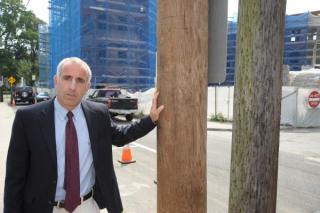They are scattered by the thousands on Long Island. Some are deemed a public hazard. All are considered a nuisance and a blight.
Double poles -- when a utility company installs a new pole near a damaged pole and leaves the old one in place -- trigger hundreds of constituent calls. Now legislators say a law passed last month in Suffolk County could help alleviate the problem.
The law requires utilities to remove their cables, terminals, conductors and other fixtures from double poles on county roads within 60 days upon notice or face a fine of $1,000 per month, per pole. For damaged poles that pose a "potential threat to public safety," utilities have to act faster -- within 15 days of notification or face fines of up to $250 per day for each violation.
The utility that owns the double poles has 30 days after all attachments have been taken off to remove the old pole or face a fine of $1,000 per month for each pole. A private vendor will survey the poles and bill the utilities.
"Once it's in the economic interest of a utility company to move their utilities to the new pole, they'll do it," said Legis. Jay Schneiderman (I-Montauk), who drafted the legislation. "They haven't in the past because there was no incentive."
The regulations could spread to Nassau, where officials are examining the Suffolk law to see whether similar legislation should be enacted there, said Katie Grilli-Robles, a county spokeswoman.
Utility company representatives acknowledge double poles are an eyesore and said the companies will comply with the new policy.
The Long Island Power Authority owns 350,000 of the roughly 570,000 poles on Long Island on which it runs wires, said Nick Lizanich, vice president of transmission and distribution operations for LIPA. Verizon owns most of the others, he said.
Lizanich said the first company to pull its hardware from an old pole is supposed to notify the other companies, which then transfer their equipment to the new pole. The last to remove hardware is responsible for taking down the old pole, he said.
Lizanich described LIPA as being "pretty current" with removing the old poles. LIPA spokesman Mark Gross said "less than 3 percent of all double woods on Long Island are LIPA's issue."
"I know some municipalities are very upset . . . but let's make sure that the right people are attending to the work that needs to be done," Lizanich said.
Verizon spokesman John Bonomo said the company owns about 216,000 poles on Long Island and is up to date in removing double poles that are "free from all third-party attachments. We are not always made aware of the work that other companies and towns and villages have done -- or not done -- on the poles," he said in an email.
Bonomo said 54 companies are tenants on Verizon's poles and "in most cases, Verizon is charged with removal of an old pole" but the company needs to wait for tenants to remove their hardware.
Sarah Chaikin, a spokeswoman for Cablevision, which owns Newsday, said in a statement that Cablevision is "up-to-date with all transfer requests" for utility lines.
The new law in Suffolk is based on legislation enacted in Southampton Town in 2010. As a result, more than 800 double poles were removed from town roads in 2011, said Councilwoman Bridget Fleming, who proposed the legislation. Utilities have responded so quickly; no fines have been levied, Fleming said.
"It was something the utility companies were not putting their crews to work on," she said.
While a handful of villages have adopted their own laws, Schneiderman estimated there were still more than 12,000 double poles throughout Suffolk. Grilli-Robles said she did not know how many were in Nassau. "I look at this as visual blight . . . , it's like litter," Schneiderman said.
LIPA and Cablevision officials expressed support for the Suffolk law. However, Verizon's Bonomo said it's unnecessary "since the company already works closely with county officials and other companies to swiftly address any double pole situations that might pose a safety concern."
Bonomo said that instead of creating a patchwork of local laws, municipalities should look to a mandate issued last year by the state Public Service Commission (PSC) that requires utility pole owners to implement a system that will track the status of pole replacements.
Under a system that is expected to be in effect by next month, the commission will receive weekly reports from utilities on double-pole sites, and each utility will be allotted a time frame to finish their work.
"If the PSC wants to do more, that's great," Schneiderman said. "But meanwhile, somebody has to do something. Everywhere you look, you see a double pole."

